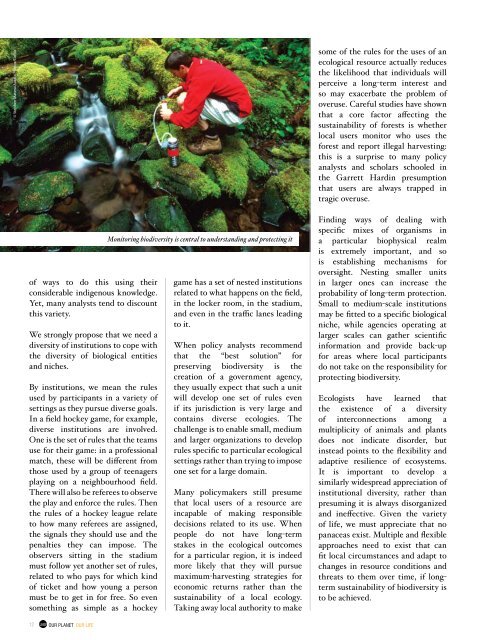BIODIVERSITY - Our Planet
BIODIVERSITY - Our Planet
BIODIVERSITY - Our Planet
You also want an ePaper? Increase the reach of your titles
YUMPU automatically turns print PDFs into web optimized ePapers that Google loves.
© Stephen Matera/Aurora Photos/Corbis<br />
some of the rules for the uses of an<br />
ecological resource actually reduces<br />
the likelihood that individuals will<br />
perceive a long-term interest and<br />
so may exacerbate the problem of<br />
overuse. Careful studies have shown<br />
that a core factor affecting the<br />
sustainability of forests is whether<br />
local users monitor who uses the<br />
forest and report illegal harvesting:<br />
this is a surprise to many policy<br />
analysts and scholars schooled in<br />
the Garrett Hardin presumption<br />
that users are always trapped in<br />
tragic overuse.<br />
of ways to do this using their<br />
considerable indigenous knowledge.<br />
Yet, many analysts tend to discount<br />
this variety.<br />
We strongly propose that we need a<br />
diversity of institutions to cope with<br />
the diversity of biological entities<br />
and niches.<br />
By institutions, we mean the rules<br />
used by participants in a variety of<br />
settings as they pursue diverse goals.<br />
In a field hockey game, for example,<br />
diverse institutions are involved.<br />
One is the set of rules that the teams<br />
use for their game: in a professional<br />
match, these will be different from<br />
those used by a group of teenagers<br />
playing on a neighbourhood field.<br />
There will also be referees to observe<br />
the play and enforce the rules. Then<br />
the rules of a hockey league relate<br />
to how many referees are assigned,<br />
the signals they should use and the<br />
penalties they can impose. The<br />
observers sitting in the stadium<br />
must follow yet another set of rules,<br />
related to who pays for which kind<br />
of ticket and how young a person<br />
must be to get in for free. So even<br />
something as simple as a hockey<br />
Monitoring biodiversity is central to understanding and protecting it<br />
game has a set of nested institutions<br />
related to what happens on the field,<br />
in the locker room, in the stadium,<br />
and even in the traffic lanes leading<br />
to it.<br />
When policy analysts recommend<br />
that the “best solution” for<br />
preserving biodiversity is the<br />
creation of a government agency,<br />
they usually expect that such a unit<br />
will develop one set of rules even<br />
if its jurisdiction is very large and<br />
contains diverse ecologies. The<br />
challenge is to enable small, medium<br />
and larger organizations to develop<br />
rules specific to particular ecological<br />
settings rather than trying to impose<br />
one set for a large domain.<br />
Many policymakers still presume<br />
that local users of a resource are<br />
incapable of making responsible<br />
decisions related to its use. When<br />
people do not have long-term<br />
stakes in the ecological outcomes<br />
for a particular region, it is indeed<br />
more likely that they will pursue<br />
maximum-harvesting strategies for<br />
economic returns rather than the<br />
sustainability of a local ecology.<br />
Taking away local authority to make<br />
Finding ways of dealing with<br />
specific mixes of organisms in<br />
a particular biophysical realm<br />
is extremely important, and so<br />
is establishing mechanisms for<br />
oversight. Nesting smaller units<br />
in larger ones can increase the<br />
probability of long-term protection.<br />
Small to medium-scale institutions<br />
may be fitted to a specific biological<br />
niche, while agencies operating at<br />
larger scales can gather scientific<br />
information and provide back-up<br />
for areas where local participants<br />
do not take on the responsibility for<br />
protecting biodiversity.<br />
Ecologists have learned that<br />
the existence of a diversity<br />
of interconnections among a<br />
multiplicity of animals and plants<br />
does not indicate disorder, but<br />
instead points to the flexibility and<br />
adaptive resilience of ecosystems.<br />
It is important to develop a<br />
similarly widespread appreciation of<br />
institutional diversity, rather than<br />
presuming it is always disorganized<br />
and ineffective. Given the variety<br />
of life, we must appreciate that no<br />
panaceas exist. Multiple and flexible<br />
approaches need to exist that can<br />
fit local circumstances and adapt to<br />
changes in resource conditions and<br />
threats to them over time, if longterm<br />
sustainability of biodiversity is<br />
to be achieved.<br />
12<br />
OUR PLANET OUR LIFE

















